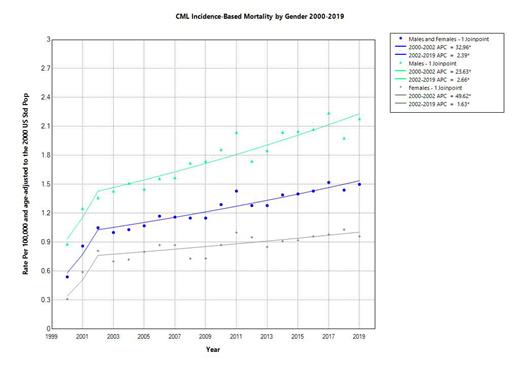Incidence-Based Mortality Rates For Chronic Myeloid Leukemia (CML) In Adult US Populations by Gender and Race: The Aftermath of Tyrosine Kinase Inhibitors (TKIs)
Background:
Chronic Myeloid Leukemia (CML) is one of the leading causes of Leukemia in North America and world wide. According to the American Cancer Society, 1 in 526 Americans will develop CML during their lifetime. CML accounts for about 15% of all new cases of leukemia. Estimates for new cases diagnosed in the United States in 2023 is about 8,930, with roughly 42% of these new cases in females and 58% in males.
We looked at the incidence based mortality rates (probability of dying from) of CML by gender and race in adult populations in the United States from 2000-2019 via SEER.gov database.
Methods:
We used Incidence -Based Mortality SEER Research Data, 17 Registries, Nov 2021 Sub (2000-2019), which provides the broadest geographic coverage for incidence-based mortality rates and is roughly 26.5% of the US population (based on the 2020 Census) for the calculation of incidence rates of CML. SEER*Stat 8.4.1 was used to obtain age-adjusted rates for different age-groups, races and genders. We used Join-point software, version 5.0.2. by the National Cancer Institute, annually to create log-linear time trends.
There are no P-values noted for the CI as Joinpoint does not currently produce a test statistic or p-value for Empirical Quantile confidence intervals.
Results:
Fig 1: CML Incidence Based Mortality Rate per 100,000 and age-adjusted to the 2000 US standard population for males and females 2000-2019
We identified a total of 1,183,747,806 diagnosed cases of CML between 2000-2019 among males and females in the United States. A dainty rise in the number of diagnosed cases was appreciated over the years, with 52,890,308 cases diagnosed in the year 2000 and 64,920,828 in the year 2019.
The trend for CML among males show an increasing Incidence Based Mortality between 2000-2019 with an Average Annual Percent Change(AAPC) of 4.69%*CI 3.40 to 5.95), and 5.85%*(CI 4.54 to 8.35) in females.
The AAPC for Whites, Black, American Indian/Alaska native and Asian or Pacific Islander were 5.51%* (95% CI 4.72 to 6.59), 2.03%*(95% CI 0.64 to 3.79), 3.12% (-2.15 to 10.78), and 2.42%*(95% CI 0.22 to 6.05) respectively.
Conclusion:
The denouement of our study shows a significant high rate of change in increasing incidence based mortality rate of CML in the US adult population from ages 20 years and older prior to 2002.The rate of change significantly drops after 2002, as noted in males, females and whites.
Incidence based mortality was also noted to be significantly higher among males compared to females.
Regarding race, the trend shows higher rates among whites and blacks compared to Asians or American Indians.
The evidence points to some changes or events in or around the year 2002 that have significantly impacted the probability of dying from CML in the adult populations in the United States. This significant change coincides with the approval of Tyrosine Kinase inhibitors, with Imatinib (Gleevec) being the first one approved in 2001.
Disclosures
No relevant conflicts of interest to declare.


This feature is available to Subscribers Only
Sign In or Create an Account Close Modal